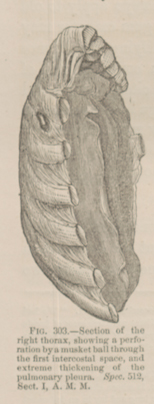Title: B——, William
Source text: Surgeon General Joseph K. Barnes, United States Army, The Medical and Surgical History of the War of the Rebellion. (1861–65.), Part 1, Volume 2 (Washington, D.C.: Government Printing Office, 1870), 618.
Civil War Washington ID: med.d1e20357
TEI/XML: med.d1e20357.xml
FIG. xxx.—Private William B——, Co. F, 6th Wisconsin Volunteers, aged 18 years, was wounded in the first battle in which his regiment participated, at Gainesville, August 28th, 1862, the first of the series of engagements included under the title of the Second Battle of Bull Run. He was shot through the right chest, and was left upon the field for several hours, but was finally provided with shelter at a field station of the First Army Corps. There was not much bleeding; but a frequent painful cough, with bloody sputa, and dyspnœa, and anxiety, and a quick small pulse. Occasional stimulants, with small anodynes, and cooling drinks, constituted the general treatment, and the local treatment consisted in covering the orifices of the wounds with compresses secured by adhesive strips. On September 2d, he was placed in an ambulance train, and, after a weary journey, over rough roads, of over thirty miles, he was admitted to College Hospital, Georgetown, September 6th, 1862, according to the memorandum of Acting Assistant Surgeon J. Morris Brown, "with a perforating gunshot wound of the thoracic cavity; the missile entered on the right side, between the first and second ribs, about one and a half inches from the costal cartilages, passed downward and backward, perforated the right lung, and emerged at the angle of the fifth rib, which it comminuted, besides chipping the sixth. There was effusion in the right pleura; sonorous rales; exaggerated breathing; he also spat blood." The prescription book of the hospital is the only guide to the progress of the case during the six weeks which elapsed before its fatal termination. Death resulted on October 21st, 1862. The necropsy revealed the track of the ball. The wood-cut (FIG. 303) represents a preparation of the right lung and of six ribs of the same side. The lung is collapsed and solidified and the pleura intensely thickened after inflammation, the pleura pulmonalis being about two and a half lines in thickness. There is a corresponding thickening of the costal membrane. The specimen was contributed, with a brief note of the case, by Acting Assistant Surgeon G. K. Smith.
